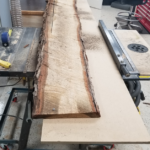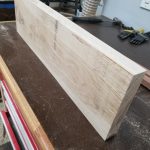The oak I cut down last fall and “milled” last winter (this post) seemed to be dry enough to attempt further processing. Since the milling was very crude, there was a lot of thickness variation and therefor a lot of variation in moisture content. It hasn’t been a full year, but it’s also been a hot/dry summer. I measured an average of about 11% moisture content, which is near the lower limit that can be expected for outdoor drying in my area. Turning the log into lumber consisted of a few steps:
#1 – Rip a straight edge along one side of each plank. Since the log doesn’t have any straight reference surface, I created a sled out of some spare 1/2″ MDF and attached the plank to the sled. The sled provided a straight edge to ride along the table saw fence, ensuring a straight cut edge on the plank.
#2 – After the 1st straight edge is cut, the sled is removed and the newly cut straight edge rides against the fence while the other side of the plank is ripped.
#3 – With the sides now flat and parallel, a flat face needed to be established. To do this I put the plank on a long 2×6 and shimmed it until it no longer rocked. I fed the entire stack through the planer with multiple passes until a flat face was established across the entire side.
#4 – With 1 flat face established, the plank was removed from the 2×6 and fed through the planer until a new face was established across the other side.
#5 – The ends were cut on the table saw to be square with the sides.
For this initial test I used the board from the top of the stack. This top board had warped a good bit, so instead of trying to plane the warp out, which would have created a very long/thin board, I cut the plank into sections to create shorter/thicker boards. For future drying stacks I need to add weight on the top to prevent warping of the top planks(s).
After planing the first board I am seeing some cracks form. The normal process is to allow the wood to finish drying inside after the outside drying phase is complete, so this wasn’t necessarily a surprise. I’ll likely leave the rest of the log in the garage to finish drying to ~8%, and then re-process the test pieces with the full log once they’re fully dry and stable.
I’m planning to ‘mill’ the rest of the logs soon and put them in this log’s prior location outside, protected by the eave of the garage roof. These should be ready for initial processing and moving into the garage next fall; by then this initial log should be processed into final lumber and will be out of the way.




